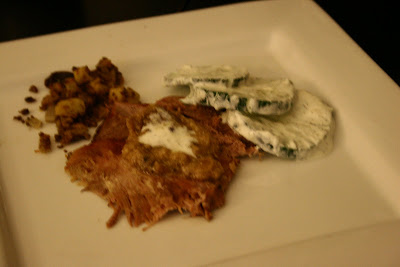Book: War and Peace by Leo Tolstoy
Recipes: Mrs. T's Pierogies
Stone Imperial Stout
Cooking Around the World: Russian and Polish by Lesley Chamberlain and Catherine Atkinson
Music: Prokofiev - War and Peace
Stone Imperial Stout
Cooking Around the World: Russian and Polish by Lesley Chamberlain and Catherine Atkinson
Music: Prokofiev - War and Peace
Mrs. T's Frozen Pierogies
We baked them, then fried them in olive oil and served them with the requisite sour cream. They were a little dry; I think because of the baking. Next time I will steam them and then fry them in butter.
For a giant bag (it was the only one they had in the freezer section and it was also on sale) of mass marketed frozen Pierogies, they could have been worse. I most certainly would have done better to head to a Russian or Polish store and get some fresh ones. Very soon I will be purchasing a rolling pin and assembling a crack team of Pierogie stuffers and making my own.
Stone Imperial Russian Stout
10.5% Alcohol by volume. Allegedly brewed in the style of the Czars who liked their beers dark, it's thick, rich, and delicious. And too much of a good thing will knock you on your ass (just ask Sam).
Lamb Plov
1/2 cup raisins
1/2 cup prunes
1 tbsp lemon juice
2 tbsp butter
1 large onion chopped
1 lb cubed lamb fillet
8 oz ground lamb
2 cloves crushed garlic
2 1/2 cups vegetable or lamb stock
1/2 cups long grain rice
Large pinch of saffron
salt and pepper to taste
Put the raisins and prunes in a bowl with just enough water to cover them and add the lemon juice. Set this aside and start browning the onions and garlic in butter. Add the meats and brown them for 5 minutes. If you are like me, and you can't, apparently read, you may have over purchased the ground lamb and gotten a full pound instead of just 8 ounces. This will not ruin your recipe, but will make it much richer and meatier. Stir in 2/3 cup of the stock; bring to a boil then cover, reduce heat, and simmer for 1 hour or until lamb is tender. I used the remaining Vegetable Better than Bouillion that I managed to scrape out of the jar. After the hour has passed, add the remaining broth, saffron, and rice, bring to a boil, then reduce heat, cover and simmer until rice is tender. If you live near the 125th St. Pathmark in Harlem, you already know how huge it is, and that it has a ton of odd products you might not find anywhere else in the neighborhood as well as a reputation for 20-30 minute wait times at the register. You may also know (as I do... now.) that it does not sell vegetable stock in any form that's not the Lipton Onion Soup and Recipe Mix that my grandma always made into French Onion Dip for the Super Bowl. I had to use this soup in my recipe and cut out the extra salt. I also used brown basmati rice which takes a lot longer to cook than regular rice and which absorbs liquid a bit differently I think. Following these adaptations, your Plov will be more saucy and a little darker brown than the picture in the cookbook. When your brown rice is finally cooked, add the raisins and prunes right at the end, and heat through. Serve with some kind of green vegetable that was not indigenous to Russia, but which will prevent you from being bored with all this brown food. I used plain steamed broccoli and the combination of flavors (and a little color on the plate) paired very well.
About the book: Nataly Rostov is a fool. A fool in love with love who is about to attempt an elopement with one of the biggest liars and womanizers in Moscow. I liked her character when she was engaged to Andrew Bolkonski; she was a young girl learning to be a woman and she was interested in being intelligent and cultured for Andrew. Now that she is about to throw him over for Anatole Kuragin, I almost don't even want to read about her. She is obsessed with his obvious pleasure in her beauty which means she is really just obsessed with herself. He has written her two letters and met her about four times. He is already secretly married to some country peasant woman he compromised whose father apparently caught up with him. He didn't even write her the first love letter; Bergerac-style, he got his friend to write it for him.
What is most interesting is the way in which Tolstoy captures that hysterical nature of a stubborn woman who is bent on doing something she knows is stupid but who cannot stop herself. She was screaming at her friend "I hate you! I hate you! I hate you!" She is clearly afraid to hear the truth about Anatole, which is that he's a bastard.
About the music: The opera, of course, cuts out so much of the book. I've never heard a Russian opera before, but it's not that much different from most of the others. And of course, I read all the song titles and now I'm curious to know whether Natasha and Andrew get back together before the end, or whether a bunch of Natasha's loves die in the burning of Moscow.













